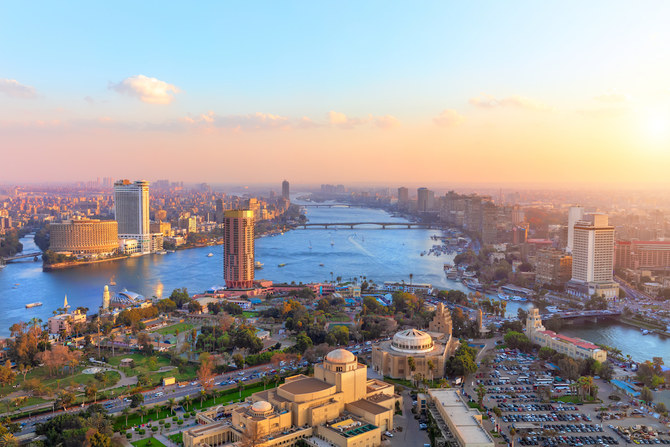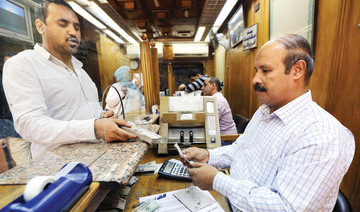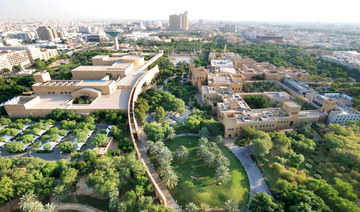CAIRO: Egypt has received the final $2 billion tranche of its IMF loan, state television said on Monday.
Last month, the IMF said Egypt could draw the sixth and final tranche of the $12 billion, three-year loan program that began in 2016 after concluding its fifth and final review of Egypt's economic reforms last month.
As part of the IMF deal, Egypt has been pushing ahead with tough economic reforms including the latest round of fuel subsidy cuts in early July, which raised domestic prices by between 16% and 30%.
"Egypt has successfully completed the three-year arrangement under the Extended Fund Facility and achieved its main objectives," IMF Acting Managing Director David Lipton said in a statement after the final review in July.
Reforms have included the introduction of a value-added tax, deep cuts to energy subsidies and a currency devaluation, putting the budgets of tens of millions of Egyptians under strain.
The changes are aimed at luring back investors who withdrew funds from Egypt during the 2011 uprising that overthrew former dictator Hosni Mubarak.
Egypt receives final $2bn tranche of IMF loan
Egypt receives final $2bn tranche of IMF loan

GCC countries to lead Mideast energy transition

- saudi Arabia, UAE, and Oman to account for two-third of region’s solar capacity
RIYADH: Saudi Arabia, the UAE, and Oman are set to lead the Middle East’s solar transition thanks to several key factors, according to a new report.
In its latest analysis, Norwegian business intelligence and research company Rystad Energy stated that solar power is becoming increasingly important in the energy policies of Middle Eastern countries.
As the cheapest energy source, solar photovoltaics in Saudi Arabia has achieved a world record-low levelized cost of electricity of $10.4 per megawatt-hour, the report stated. It further explained that this is due to factors such as low hurdle rates, large-scale projects, and declining hardware prices, as well as low labor costs and high solar irradiance.
“The region has exceptional solar energy potential, receiving more than 2,000 kilowatt-hours per sq. m. annually in solar irradiation in countries such as Saudi Arabia, the UAE, and Oman,” the report stated.
The total solar capacity in the Middle East at the end of 2023 exceeded 16 gigawatts and is expected to approach 23 GW by the end of 2024, the report added.
Rystad Energy’s projections indicate that by 2030, the capacity will surpass 100 GW, with green hydrogen projects contributing an annual growth rate of 30 percent.
The report stated that Saudi Arabia, the UAE, and Oman are on track to collectively account for nearly two third of the region’s total solar capacity by the end of the decade.
By 2050, renewable sources, including hydro, solar, and wind, are expected to constitute 70 percent of the Middle East’s power generation mix, a significant leap from 5 percent at the end of 2023, the report stated.
Despite this surge, the region will rely heavily on natural gas in the short term, with usage peaking around 2030.
The report added that at the end of 2023, 93 percent of the Middle East’s power generation was from fossil fuels, with renewables at 3 percent and nuclear and hydro at 2 percent each.
By 2030, 30 percent of installed capacity is expected from renewables, potentially reaching 75 percent by 2050.
Rystad Energy predicts battery energy storage will grow significantly in the 2030s, supporting the transition to solar and wind power. The share of gas in power generation is expected to decrease from 74 percent in 2023 to 22 percent by 2050.
Saudi Manpower Solutions Co. eyes expansion following its public listing

RIYADH: Various sectors across different parts of Saudi Arabia will soon have greater and easy access to manpower as the country’s first service provider eyes expansion with its initial public offering.
Speaking to Arab News, Abdullah Al-Timyat, CEO of Saudi Manpower Solutions Co., known as SMASCO, said the IPO will help propel SMASCO within the Saudi market, drive growth initiatives, and fortify its presence and stakeholders’ trust.
Al-Timyat said the IPO proceeds will not be utilized for internal operations but will be earmarked for strategic growth initiatives to expand the company’s footprint across the Kingdom’s diverse market.
He added the company’s capital-light model, fortified by no debt and robust cash management, positions it for agile expansion. “We have zero debt and funding. We have strong cash management, and we have enough internal funds for our operations. So, the IPO will enable SMASCO in its future steps and strategic direction in expanding within the Saudi market, reaching new geographic cities and regions within Saudi Arabia.”
With an eye on deepening market penetration, Al-Timyat outlined SMASCO’s strategic direction, leveraging the IPO’s support to enhance brand awareness and stakeholders’ trust.
“We will even go deeper … within specific sectors, in business industry and professional manpower, depending on a more trusted bond that we have available because of the IPO and the support that we will have.”
The executive outlined the company’s current focus on the Kingdom’s market, emphasizing its vast potential and opportunities for manpower companies, including SMASCO.
He also underscored the entity’s mature model and expertise in technologies, which position it to potentially expand into new markets in the future. While there are no immediate plans to venture beyond Saudi Arabia, SMASCO remains prepared to seize opportunities should they arise, he said.
Looking ahead, the CEO highlighted artificial intelligence’s transformative potential emphasizing its role in enhancing efficiency and service delivery.
He said: “AI and advanced technology is an opportunity for manpower companies. This is how we see it in SMASCO, this will provide us more opportunities, a faster a road to (achieve) our objectives operationally, financially and even for our customers.”
Al-Timyat highlighted the pivotal role of Vision 2030 benchmarks in providing clarity and direction to SMASCO’s future endeavors.
“Since the government launched Vision 2030, we have a clarity where we are going and this makes it easier for any industry, for any investor. We see a persistence of execution by the government, which we have never witnessed before and this is actually aligned with what we are seeing.”
This synergy between technological innovation and national objectives supports industry advancement. The executive noted that it is set to drive economic growth and societal development in alignment with the Kingdom’s ambitious vision.
Al-Timyat also outlined the global demand for various industries, including medical, logistics, tourism, and entertainment, which are also prevalent in Saudi Arabia.
Each of these industries requires specific qualities for talents and specialized manpower services to address their unique needs, he noted.
The executive said SMASCO, specialized in manpower solutions, has created subsectors within its team to cater to diverse industries.
This focus on specialization enables SMASCO to provide high-quality services that align with the economy, market trends, and specific requirements of each industry.
Saudi banks’ risk profiles stronger than GCC counterparts: Fitch

RIYADH: Saudi banks exceed their Gulf Cooperation Council counterparts in terms of risk profiles underpinning their asset quality, according to Fitch Ratings.
The credit rating agency said in a statement that there is a strong correlation between asset quality and risk profile scores among regional banks, particularly in the GCC, due to their lending-focused business models. Saudi banks boast a weighted-average risk-profile score slightly below “bbb+” and a similar asset quality score.
Conversely, in the UAE, Qatar, and Kuwait, both weighted-average scores stand two notches lower, at “bbb-.”
Despite experiencing credit growth around double the GCC average between 2022 and 2023, Saudi banks maintain stronger scores. This surge is attributed to heightened government spending and robust non-oil gross domestic product growth.
However, banking assets remained at 99 percent of GDP by the end of 2023, contrasting with figures of 206 percent in the UAE, 240 percent in Qatar, and 159 percent in Kuwait.
The stronger risk profiles of Saudi banks are evident in their asset quality metrics. From 2019 to 2023, the sector’s cost of risk averaged 60 basis points, lower than the averages observed in the UAE, Qatari, and Kuwaiti banking sectors.
Similarly, the combined Stage 2 and 3 loans ratio of 7.2 percent was the lowest among the four markets.
Fitch’s assessment of Saudi banks’ stronger risk profiles reflects their generally conservative underwriting standards and risk controls.
This evaluation also acknowledges the perception that the Saudi Central Bank, also known as SAMA, is the region’s strictest and most prudent banking regulator.
“Saudi banks have less borrower concentration than the UAE and Qatari banks, but a similar level to Kuwaiti banks, due to a larger and more diversified economy and strong retail financing in 2021-2023,” the rating agency stated.
It added: “The 20 largest exposures at Saudi and Kuwaiti banks account for about 20 percent of the loan books on average, but significantly more — about 35 percent — at UAE and Qatari banks.”
Moreover, Saudi banks extend lower levels of financing to companies owned or managed by high-net-worth individuals compared to certain UAE and Qatari banks.
Saudi banks’ exposure to real estate and construction companies rose to 15 percent of gross sector financing by the end of the first quarter of 2024, up from 12 percent at the end of 2021.
This trend is anticipated to persist as non-oil sectors continue to expand. While Saudi banks’ real estate financing proportion now resembles that of Qatari and the UAE banks, it remains below the average for Kuwaiti lenders, standing at 24 percent of gross loans as of end 2023.
“We typically view high exposure to real estate financing as a weakness for GCC banks’ risk profiles and asset quality, as the exposures are mostly long-term and often non-amortizing with final repayment contingent upon full completion of the building,” Fitch said in the statement.
It added: “Potential difficulty in realizing underlying collateral or repossessing prime residences can also weigh on how Fitch views the exposures.”
Riyadh residential market sales surge 77%: CBRE report

RIYADH: Saudi Arabia’s residential market experienced robust growth in demand, with Riyadh witnessing a 77 percent year-on-year increase in sales transactions in the first quarter, a new report showed.
According to global consultancy firm CBRE, Jeddah residential transactions surged by 92.9 percent in the first three months of this year, while Dammam saw a 28.0 percent increase year-over-year.
Taimur Khan, head of research MENA, said: “Whilst we have seen strong performance across commercial sectors within Saudi Arabia in the recent past, something which continues to date, we are now beginning to see the residential sector also register a significant surge in demand. This is, in turn, underpinning performance in the sector.”
As new stock continues to be delivered, he said they expect this trend to continue, with demand outpacing supply for some time to come.
“However, we also expect that there might be some bifurcation in performance within the residential sector, with new quality assets likely to register record rates,” added Khan.
Villa prices in Riyadh, Jeddah, and Khobar rose by 3.6 percent, 0.2 percent, and 3.1 percent, respectively. Meanwhile, Dammam saw a slight decline of 0.5 percent.
In the apartment segment, prices in Riyadh, Dammam, and Khobar increased by 8.4 percent, 0.9 percent, and 0.4 percent, respectively, compared to the previous year.
However, Jeddah experienced a 1.1 percent decrease in average apartment prices over the same period.
Throughout the first quarter of this year, the office sector witnessed a slowdown in rental growth across all market segments.
Prime rents in Riyadh’s occupier market surged by 14.5 percent, while Grade A and Grade B rents increased by 11.8 percent and 10.3 percent, respectively.
In Dammam, Grade A rents rose by 8.0 percent, Grade B by 6.2 percent, and Khobar’s Grade A rents saw a 4.6 percent increase.
Occupancy rates stood at 93.8 percent, 99.7 percent, and 99.4 percent for Prime, Grade A, and Grade B segments in Riyadh, while Dammam and Khobar displayed respective Grade A occupancy rates of 86.3 percent and 85.2 percent as of the first quarter.
In Jeddah, Grade A and Grade B rents increased by 13.6 percent and 13.1 percent, respectively, with occupancy rates reaching 92.5 percent and 86.6 percent.
The hospitality sector’s performance remained strong throughout the first quarter due to high visitation levels.
Year-on-year, from January to March 2024, the average occupancy rate saw a slight uptick of 0.1 percentage points.
Additionally, the country experienced an 11.8 percent increase in average daily rate, leading to a 12.0 percent rise in revenue per available room.
Closing Bell: TASI dips to close at 11,503 points

RIYADH: Saudi Arabia’s Tadawul All Share Index dipped on Thursday, losing 193.02 points, or 1.65 percent to close at 11,503.49
The total trading turnover of the benchmark index was SR13.13 billion ($3.50 billion) as 65 stocks advanced while 161 retreated.
Similarly, the MSCI Tadawul Index dipped by 24.77 points, or 1.70 percent, to close at 1,436.07.
However, the Kingdom’s parallel market, Nomu, increased by 307.64 points or 1.17 percent, to close at 26,610.57. This comes as 28 stocks advanced, while as many as 30 retreated.
The best-performing stock was the Mediterranean and Gulf Insurance and Reinsurance Co., as its share price surged by 7.66 percent to SR29.50.
Other top performers included Almasane Alkobra Mining Co. and Alkhorayef Water and Power Technologies Co., whose share prices soared by 5.37 percent and 4.55 percent, to stand at SR62.80 and SR161 respectively.
National Co. for Learning and Education and East Pipes Integrated Co. for Industry also performed well.
The worst performer was ACWA Power Co. whose share price dropped by 9.98 percent to SR402.40.
Share prices of Fawaz Abdulaziz Alhokair Co. as well as the Co. for Cooperative Insurance dropped by 7.89 percent and 6.41 percent to stand at SR8.40 and SR131.40, respectively.
The best-performing stock of the day on the parallel market was Mohammed Hadi Al-Rasheed and Partners Co., as its share price surged by 12.58 percent to SR34.90.
Other top performers included Osool and Bakheet Investment Co. and Abdulaziz and Mansour Ibrahim Albabtin Co., whose share prices soared by 12.38 percent and 6.86 percent, to stand at SR44.95 and SR45.95 respectively.














